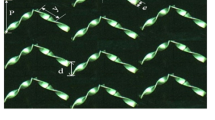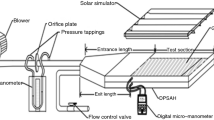Abstract
In this study, theoretical investigation derived from experimental correlations and the artificial bee colony optimization method are used to determine the optimum geometrical parameters which maximize the termohydraulic efficiency of some artificially roughened solar air heaters. Nine different roughness types are considered, i.e., transverse wedge-shaped rib roughness, protrusion roughness, multiple v-ribs roughness, rib-grooved roughness, metal grit ribs roughness, compound turbulators roughness, v-shaped rib roughness, arc-shaped wire roughness, and discrete v-down ribs roughness. The effects of the artificial roughness element parameters on the best thermal performance and the thermohydraulic performance are compared. Optimum results are obtained with multiple v-ribs roughness for the low mass flow rate (MFR = 0.1 kg/s) and with protrusion roughness for the high mass flow rate (MFR = 0.5 kg/s). Optimum roughness parameters and corresponding thermal and thermohydraulic efficiencies are tabulated for each solar collector type. As expected, increased roughness geometry leads to higher pressure loss and reduces thermohydraulic efficiency.
Similar content being viewed by others
References
A. Saxena, Varun and A. A. El-Sebaii, A thermodynamic review of solar air heaters, Renewable and Sustainable Energy Reviews, 43 (2015) 863–890.
R. Tchinda, A review of the mathematical models for predicting solar air heaters systems, Renewable and Sustainable Energy Reviews, Pergamon, 13(8) (2009) 1734–1759.
T. Alam and M. H. Kim, Performance improvement of doublepass solar air heater — a state of art of review, Renewable and Sustainable Energy Reviews, 79 (2017) 779–793.
C. Yildirim and İ. Solmus, Çift geçiçli havali güineç toplayicinin kanal yüksekliǧinin termohidrolik verime etkisinin incelenmesi, Isı Bilim. ve Tek. Derg., 34(1) (2014) 111–122.
A. K. Patil, Heat transfer mechanism and energy efficiency of artificially roughened solar air heaters — a review, Renewable and Sustainable Energy Reviews, 42 (2015) 681–689.
I. Singh and S. Singh, A review of artificial roughness geometries employed in solar air heaters, Renewable and Sustainable Energy Reviews, 92 (2018) 405–425.
G. K. Chhaparwal, A. Srivastava and R. Dayal, Artificial repeated-rib roughness in a solar air heater — a review, Sol. Energy, 194 (2019) 329–359.
T. Alam and M. H. Kim, A critical review on artificial roughness provided in rectangular solar air heater duct, Renewable and Sustainable Energy Reviews, 69 (2017) 387–400.
V. Singh Bisht, A. Kumar Patil and A. Gupta, Review and performance evaluation of roughened solar air heaters, Renewable and Sustainable Energy Reviews, 81 (2017) 954–977.
A. S. Yadav and J. L. Bhagoria, Heat transfer and fluid flow analysis of solar air heater: a review of CFD approach, Renewable and Sustainable Energy Reviews, 23 (2013) 60–79.
V. B. Gawande, A. S. Dhoble, D. B. Zodpe and S. Chamoli, A review of CFD methodology used in literature for predicting thermo-hydraulic performance of a roughened solar air heater, Renewable and Sustainable Energy Reviews, 54 (2016) 550–605.
R. Kumar, Varun and A. Kumar, Thermal and fluid dynamic characteristics of flow through triangular cross-sectional duct: a review, Renew. Sustain. Energy Rev., 61 (2016) 123–140, doi: https://doi.org/10.1016/J.RSER.2016.03.011.
P. K. Jain, A. Lanjewar, K. B. Rana and M. L. Meena, Effect of fabricated V-rib roughness experimentally investigated in a rectangular channel of solar air heater: a comprehensive review, Environ. Sci. Pollut. Res., 28(4) (2021) 4019–4055.
A. S. Yadav, M. K. Dwivedi, A. Sharma and V. K. Chouksey, CFD based heat transfer correlation for ribbed solar air heater, Mater. Today Proc., 62(3) (2022) 1402–1407.
J. L. Bhagoria, J. S. Saini and S. C. Solanki, Eat transfer coefficient and friction factor correlations for rectangular solar air heater duct having transverse wedge shaped rib roughness on the absorber plate, Renew. Energy, 25(3) (2002) 341–369.
B. Bhushan and R. Singh, Nusselt number and friction factor correlations for solar air heater duct having artificially roughened absorber plate, Sol. Energy, 85(5) (2011) 1109–1118.
V. S. Hans, R. P. Saini and J. S. Saini, Heat transfer and friction factor correlations for a solar air heater duct roughened artificially with multiple v-ribs, Sol. Energy, 84(6) (2010) 898–911.
A. R. Jaurker, J. S. Saini and B. K. Gandhi, Heat transfer and friction characteristics of rectangular solar air heater duct using rib-grooved artificial roughness, Sol. Energy, 80(8) (2006) 895–907.
S. V. Karmare and A. N. Tikekar, Heat transfer and friction factor correlation for artificially roughened duct with metal grit ribs, Int. J. Heat Mass Transf., 50(21–22) (2007) 4342–4351.
A. Layek, J. S. Saini and S. C. Solanki, Heat transfer and friction characteristics for artificially roughened ducts with compound turbulators, Int. J. Heat Mass Transf., 50(23–24) (2007) 4845–4854.
A. M. Ebrahim Momin, J. S. Saini and S. C. Solanki, Heat transfer and friction in solar air heater duct with V-shaped rib roughness on absorber plate, Int. J. Heat Mass Transf., 45(16) (2002) 3383–3396.
S. K. Saini and R. P. Saini, Development of correlations for Nusselt number and friction factor for solar air heater with roughened duct having arc-shaped wire as artificial roughness, Sol. Energy, 82(12) (2008) 1118–1130.
S. Singh, S. Chander and J. S. Saini, Heat transfer and friction factor correlations of solar air heater ducts artificially roughened with discrete V-down ribs, Energy, 36(8) (2011) 5053–5064.
R. Kumar, M. Kharub, V. Kumar and Varun, Heat augmented due to array of protrusions on absorber plate in solar heat exchanger, Mater. Today Proc., 38(5) (2021) 2425–2430.
R. Kumar, V. Goel and M. Kumar, Effect of providing gap in multiple-arc rib-roughened solar air heater — part 1, J. Mech. Sci. Technol., 34(6) (2020) 2619–2625.
I. Singh, S. Vardhan, S. Singh and A. Singh, Experimental and CFD analysis of solar air heater duct roughened with multiple broken transverse ribs: a comparative study, Sol. Energy, 188 (2019) 519–532.
K. Nidhul, A. K. Yadav, S. Anish and U. C. Arunachala, Thermo-hydraulic and exergetic performance of a cost-effective solar air heater: CFD and experimental study, Renew. Energy, 184 (2022) 627–641, doi: https://doi.org/10.1016/J.RENENE.2021.11.111.
R. Misra et al., Prediction of behavior of triangular solar air heater duct using V-down rib with multiple gaps and turbulence promoters as artificial roughness: a CFD analysis, Int. J. Heat Mass Transf., 162 (2020) 120376.
A. S. Yadav, A. Agrawal, A. Sharma and A. Gupta, Revisiting the effect of ribs on performance of solar air heater using CFD approach, Mater. Today Proc., 63 (2022) 240–252.
R. Kumar and V. Goel, Unconventional solar air heater with triangular flow-passage: a CFD based comparative performance assessment of different cross-sectional rib-roughnesses, Renew. Energy, 172 (2021) 1267–1278.
A. Haldar, L. Varshney and P. Verma, Effect of roughness parameters on performance of solar air heater having artificial wavy roughness using CFD, Renew. Energy, 184 (2022) 266–279.
S. Singh, S. Chander and J. S. Saini, Thermo-hydraulic performance due to relative roughness pitch in V-down rib with gap in solar air heater duct — comparison with similar rib roughness geometries, Renewable and Sustainable Energy Reviews, 43 (2015) 1159–1166.
A. Çencan Çahin, Optimization of solar air collector using genetic algorithm and artificial bee colony algorithm, Heat Mass Transf., 48(11) (2012) 1921–1928.
C. Yıldırım and I. Aydoǧdu, Artificial bee colony algorithm for thermohydraulic optimization of flat plate solar air heaters, J. Mech. Sci. Technol., 31(7) (2017) 3593–3602.
A. Kumar and A. Layek, Thermo-hydraulic performance of roughened solar air heater by design of experiment and metaheuristic approach, Therm. Sci. Eng. Prog., 10 (2019) 92–102.
L. N. Azadani and N. Gharouni, Multi objective optimization of cylindrical shape roughness parameters in a solar air heater, Renew. Energy, 179 (2021) 1156–1168.
K. S. Ong, Thermal performance of solar air heaters: mathematical model and solution procedure, Sol. Energy, 55(2) (1995) 93–109.
J. A. Duffie and W. A. Beckman, Radiation transmission through glazing: absorbed radiation, Solar Engineering of Thermal Processes, 4th Ed., John Wiley & Sons, Ltd (2013) 202–235.
A. A. El-Sebaii, S. Aboul-Enein, M. R. I. Ramadan, S. M. Shalaby and B. M. Moharram, Investigation of thermal performance of double pass-flat and v-corrugated plate solar air heaters, Energy, 36(2) (2011) 1076–1086.
D. Karaboga, An Idea based on Honey Bee Swarm for Numerical Optimization, Technical Report-TR06, https://abc.erciyes.edu.tr/pub/tr06_2005.pdf (2005).
Author information
Authors and Affiliations
Corresponding author
Additional information
Cihan Yıldırım completed his Ph.D. at Engineering Science Department Middle East Technical University. He is working as an Associate Professor at Aǧrı İbrahim Çeçen University. He is currently working on solar energy conversion devices and desalination systems.
Ibrahim Aydoǧdu completed his Ph.D. at Engineering Science Department Middle East Technical University. He is working as an Associate Professor at Civil Engineering Department Akdeniz University. He is currently working on structural optimization and steel structures.
Rights and permissions
About this article
Cite this article
Yıldırım, C., Aydoǧdu, I. Comparison of optimized roughness parameters of some artificially roughened solar air heaters. J Mech Sci Technol 36, 5267–5280 (2022). https://doi.org/10.1007/s12206-022-0939-3
Received:
Revised:
Accepted:
Published:
Issue Date:
DOI: https://doi.org/10.1007/s12206-022-0939-3




